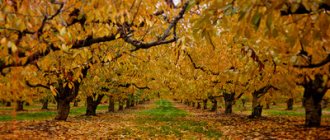Autumn in the life of birds
Autumn is one of the important periods in the life of birds, after breeding, since in a short period of time, birds need to have time to molt, gain a certain supply of fat in order to go to tropical countries for the winter. However, for some species, “autumn” comes even earlier - at the end of June, that is, long before real autumn.
The curlew leaves its breeding grounds at the end of June, when most species have just hatched their chicks. The bird arrives in April and hatches its chicks in May, spending only a month on breeding. This behavior is apparently associated with changes in the light regime in nature, as well as atmospheric pressure, which is considered a stimulus for flights. However, presumably these phenomena encourage the curlew to wander rather than actually fly away from the breeding grounds, since it makes flights already at the end of July. The bulk of the bird population leaves their nesting sites in late August - early September, but some species linger until October. Most birds migrate after breeding in search of food. Many passerines - redstarts, warblers, warblers, bluethroats, garden warblers, living in summer cottages and garden plots, feed on berries, supplying their bodies with vitamin feed. This is especially true for starlings, which sometimes even cause significant damage to crops and sometimes account for up to 40 percent of the total mass of birds in the region. Other bird species (insectivores) roam the steppe areas in search of insects (especially locusts).
Beauties change their outfits However, first of all, after breeding and before migrations, birds experience a change in plumage, that is, molting. Molting - the change of plumage from summer (breeding) to winter (annual) plumage - is the main stage in the life of birds, occurring at the end of summer. Most birds molt completely (adults) in the fall, and partially in the spring; For many birds, autumn molting is a change of plumage from summer to winter; for young (not molted) birds, it is a sign of puberty. Molting in birds occurs under the influence of special hormones that act on the body as a stimulant to renew plumage. Many birds are not seen or heard during the molting period, as they lose the ability to fly, and this borders on a stressful period: this is why songbirds are not heard at such times! The change of outfits, as well as the flight itself in birds, is associated with a change in daylight hours, or rather its duration, since under the influence of special hormones, birds lose sexual activity and they acquire winter attire. This is affected by changes in day length, as well as night temperature. Molting takes quite a long time for some birds, and very short for others. So, for example, a crow takes five to six weeks to change its feathers, while a chiffchaff, cuckoo and others take two to three weeks. This is due to the early departure of some birds and the later migration of other birds. However, those species that molt completely and in a short time lose the ability to fly. Birds that change their plumage over a long period of time and partially retain their flight qualities, but completely change their plumage already at their wintering grounds. For example, ducks and geese molt in ponds because they lose the ability to fly. Others, for example, cranes, molt partially and do not lose their flight qualities, but, having flown to their wintering grounds, change their plumage completely. All birds molt differently: some prefer to hide in bushes, trees, reed thickets, cattails, usually alone, while others prefer to hide in open places (reservoirs), but always in flocks (waterfowl). For example, ducks, geese, moorhens, coots, and some waders gather on large steppe lakes, where up to several hundred thousand individuals accumulate. Almost the entire Northern Kazakhstan was famous for its flocks of thousands of moulting ducks and geese, but at this time there are only a few thousand of them left.
***
The second stage in the autumn life of birds is the accumulation of fat reserves of their own body. This period is necessary both for birds that are still moulting and for those that have already moulted, since at this moment birds require increased nutrition (hyperphagia). Many species feed intensively to accumulate a balance of fat, which will serve as “fuel” for long-distance flights. The main food for birds is insects: this is typical even for granivorous birds that feed in meadows and fields. Rooks, jackdaws, crows, starlings and sparrows roam through meadows and wastelands, hunting for insects, including the locust, which is abundant in late summer and early autumn. Herring gulls, kites, common falcons, merlins, and kestrels live near city dumps, feeding on a variety of foods: gulls on carrion and kitchen scraps, and kites on garbage. And most often they fly in the city, hunting pigeons; kestrels find rodents here, and caps and merlins find small passerine birds: wagtails, sparrows, starlings. For most birds, increased nutrition will help them overcome vast distances to their wintering grounds, but it happens that some individuals become so oversaturated with food that they lose the ability to fly! Such individuals stay for a short time, and then still fly away, but even in this case, not all of them can fly away; those who remain at breeding or breeding sites themselves become food for predators or die from the cold. Therefore, it is important for birds not to overeat and accumulate the necessary balance of fat for flights. Migration associated with the search for food causes the so-called pre-migration state in birds. This condition will last for them until cold weather sets in and their food (for example, insects) disappears.
***
And finally, the third stage in the autumn life of birds is migration, flights from temperate zones to the tropics. Migrations are essentially flights of birds in search of food and warm places for wintering. The main factor for their flights is the light regime, or more precisely, the decrease in day length. Birds sense this phenomenon long before the onset of cold weather and therefore fly away earlier. Such a premonition among birds developed back in the era of the last ice age, when most of the territory of Eurasia was covered with an ice shell. Since then, most species fly away to the equator for the winter, returning in the spring to the temperate latitude zone to give at least one generation of descendants per year! Autumn migrations are fundamentally different from spring migrations in that in spring the main reason for migration is reproduction, and in autumn it is the search for food and warm places. Migrations in birds occur in different ways. Some fly alone, others in a flock; some move at night, others during the day. The flight also occurs at different altitudes. Some fly high, others fly low, almost at the surface of the earth. So, for example, cuckoos, nightjars, kingfishers, orioles fly alone and mainly at night (although orioles fly during the day), and raptors, ducks, pelicans, thrushes, wagtails, larks, starlings, tits, finches - during the day and mostly in a small group or in a flock. The speed and direction of migrations also vary among different species: for example, falcons, some waders, and terns fly at a speed of 50-70 kilometers per hour, but autumn migrations are much slower, since during these periods they often stop to feed and rest. Also, the direction of flights has different paths: for example, starlings nest in Kazakhstan, and fly away, as a rule, to Central Asia, China, and those birds that nested in Russia (mainly in its middle part), then fly to Crimea, in the Caspian Sea, as well as in the Mediterranean. This direction of flight of one species is apparently characterized by a shortening of migration routes. And there is not enough food for all the birds in one place. Many birds travel long distances. Therefore, both departure and arrival depend on the wintering places: scientists have noted that the greater the distance, the later the birds arrive and fly away a little earlier than others. For example, the Dubrovnik Bunting arrives in June, when most birds have nested, and flies away in August. Thus, she spends at least one to one and a half months breeding one offspring per year. Other birds fly in different ways and to different countries: cuckoos, gulls, orioles, many herons - to India, starlings, some terns, pelicans, swans - to the Crimea and on the Caspian coast, geese, geese, buntings, some rails – corncrake and crakes – to Indonesia. Most birds of prey winter in Asia, but there are also those that fly to Arabia and tropical Africa. That's why they fly in different ways. Predators, cuckoos, thrushes, flycatchers, orioles, finches stick mainly to forest belts, tracts, and so on, and seagulls, waders, geese, geese, ducks, herons and other species living near water bodies fly through water spaces. There are birds that fly through meadows, fields, mountains, and less often - deserts. Such birds often fly to savannah Africa, to the fields of India and Indonesia (Java, Kalimantan, Sumatra). Overcoming enormous distances (on average 10-15 thousand kilometers), the birds reach their wintering grounds in October-November, and in February-March they are already heading back; therefore, they spend about three to four and a half months on the flight.
Some species, such as geese and geese, fly over mountain ranges and must travel at very high altitudes. For example, mountain and gray geese fly at an altitude of about 10,000 meters above the ground, as their route lies through the Himalayas, which often exceed 8,000 meters above sea level. Such a flight is not only tiring for these birds, but is also accompanied by a number of difficulties, such as squally winds and very low air temperatures - up to -50 degrees. Those species that remain for the winter in the Pavlodar region have special adaptations to harsh climate conditions: for example, crows, jackdaws, great tits, sparrows, when they molt, in addition to covert feathers, they acquire down, which serves as a heat-insulating material in the winter. Also, the diet of many species changes with the arrival of cold weather: they switch from insects to plant seeds and kitchen scraps. Therefore, these species, as a rule, do not fly, but change feeding places, covering several hundred kilometers, that is, they wander. Autumn migrations are not typical for everyone, but only for those who fly late or migrate all year round. As a rule, wagtails and thrushes roam, feeding on berries and fruits, as well as tits, nuthatches, pikas, rooks, magpies, and jackdaws. In very rare cases, nutcrackers are found here; this happens during a period when the harvest of their main food, cedar, fails. In the Irtysh region, nutcrackers fly from the Altai Territory, where they nest, and sometimes in the autumn they fly here, sticking mainly to coniferous tree stands. In late autumn, wintering birds come to us: these are the ruffed buzzard or rough-legged rough-legged buzzard, ptarmigan, waxwing, snowy owl, tap dancers, bullfinches, some buntings, and, less often, gray owls - owls that are unusual for our area. All these species, covering several thousand kilometers, fly here from the tundra, where the climate is harsh, and, wandering here all winter, they experience unfavorable periods in life. Thus, autumn in the life of birds is preparation for departure, that is, first of all, molting, then accumulation of fat balance and, finally, flight from temperate latitude zones to tropical countries. Such phenomena in nature occur over millions of years, since most birds need abundant food and warmth, and for this they travel enormous distances, but after overwintering, the birds return back to give life to a new generation and thus prolong the existence of their species for Earth.
Sergey CHIKIN, local ornithologist, member of PavGeo. Photos from open sources.
Share on social media networks
The danger of migration
Sometimes birds must fly through harsh habitats, such as deserts where there is little water or oceans where there is no place to rest and feed.
Even if they find food and water, the birds need to land on the ground, where they risk becoming prey.
There may be many predators along the migration route. Depending on their size, migrating birds become prey for wild cats, foxes, wolves, humans and other animals. Some birds may be attacked by larger bird species while in flight. Sometimes difficult weather conditions make the flight difficult and even lead to death. It happens that birds collide with airplanes, which is dangerous both for themselves and for the airplanes.








